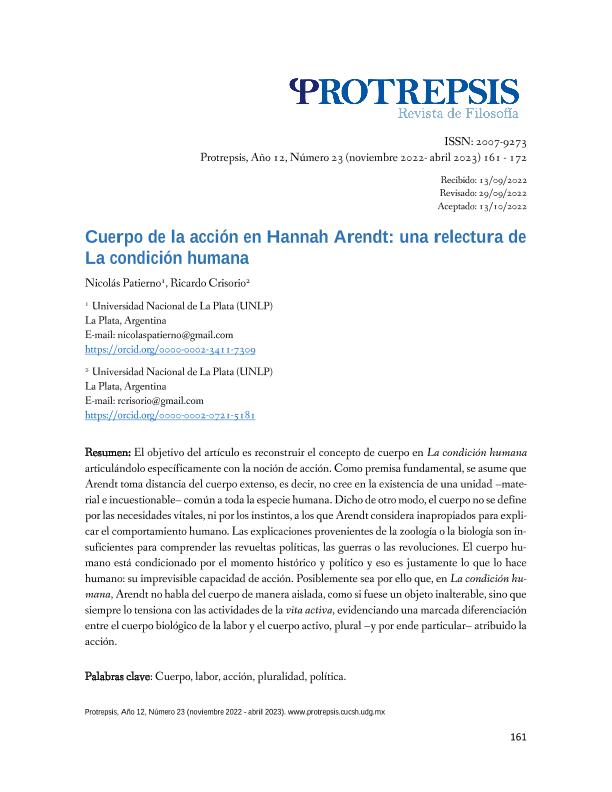Artículo
El objetivo del artículo es reconstruir el concepto de cuerpo en La condición humana articulándolo específicamente con la noción de acción. Como premisa fundamental, se asume que Arendt toma distancia del cuerpo extenso, es decir, no cree en la existencia de una unidad –material e incuestionable– común a toda la especie humana. Dicho de otro modo, el cuerpo no se define por las necesidades vitales, ni por los instintos, a los que Arendt considera inapropiados para explicar el comportamiento humano. Las explicaciones provenientes de la zoología o la biología son insuficientes para comprender las revueltas políticas, las guerras o las revoluciones. El cuerpo humano está condicionado por el momento histórico y político y eso es justamente lo que lo hace humano: su imprevisible capacidad de acción. Posiblemente sea por ello que, en La condición humana, Arendt no habla del cuerpo de manera aislada, como si fuese un objeto inalterable, sino que siempre lo tensiona con las actividades de la vita activa, evidenciando una marcada diferenciación entre el cuerpo biológico de la labor y el cuerpo activo, plural –y por ende particular– atribuido la acción. The objective of the article is to reconstruct the concept of body in The Human Condi- tion, articulating it specifically with the notion of action. As a fundamental premise, it is assumed that Arendt distances herself from the extensive body, that is, she does not believe in the existence of a unity –material and unquestionable– common to the entire human species. In other words, the body is not defined by vital needs, nor by instincts, which Arendt considers inappropriate to ex- plain human behavior. Explanations from zoology or biology are insufficient to understand politi- cal upheavals, wars or revolutions. The human body is conditioned by the historical and political moment and that is precisely what makes it human: its unpredictable capacity for action. It is pos- sibly for this reason that, in The Human Condition, Arendt does not speak of the body in isolation as if it were an unalterable object, but always associate it with the activities of the vita activa, evi- dencing a marked differentiation between the biological body of the work and the body of action, which is plural, and therefore particular.
Cuerpo de la acción en Hannah Arendt: una relectura de La condición humana
Fecha de publicación:
11/2022
Editorial:
Universidad de Guadalajara. Centro Universitario de Ciencias Sociales y Humanidades. Departamento de Filosofía
Revista:
Protrepsis
e-ISSN:
2007-9273
Idioma:
Español
Tipo de recurso:
Artículo publicado
Clasificación temática:
Resumen
Palabras clave:
CUERPO
,
ACCIÓN
,
PLURALIDAD
,
POLÍTICA
Archivos asociados
Licencia
Identificadores
Colecciones
Articulos(IDIHCS)
Articulos de INST.DE INVEST.EN HUMANIDADES Y CS SOCIALES
Articulos de INST.DE INVEST.EN HUMANIDADES Y CS SOCIALES
Citación
Patierno, Nicolas; Crisorio, Ricardo Luis; Cuerpo de la acción en Hannah Arendt: una relectura de La condición humana; Universidad de Guadalajara. Centro Universitario de Ciencias Sociales y Humanidades. Departamento de Filosofía; Protrepsis; 23; 11-2022; 161-172
Compartir




